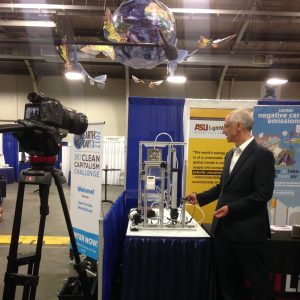May 10, 2017
 A national series of charrettes is being held to drive acceleration of all profitable clean solutions in different industries, such as oil and gas, transportation, etc.
A national series of charrettes is being held to drive acceleration of all profitable clean solutions in different industries, such as oil and gas, transportation, etc.
The goal of these charrettes is to identify and explore proposals for utilizing tax cuts to reduce emissions of air pollutants. At Arizona State University’s ASU Wrigley Institute, ASU LightWorks® hosted a charrette with the goal of developing policy proposals for clean tax cuts that would benefit research and development in clean technology, particularly technology that reduces concentrations of air pollutants in the atmosphere.
“Universities can create new technologies, but it is companies that will need to bring these to markets," says Bill Brandt, director of ASU LightWorks®. "The charrette process is a way of asking the question 'what if' and then thinking through how that helps create jobs and opportunity.”
Why are these charrettes important?
“The charrette process highlights how new technologies can lead to new jobs," explains Brandt. "To create new industries, we focused on two needs – a ‘natural’ policy and a funding environment through clean tax cuts and bringing technology to scale. To this end, we noted that U.S. federal government research grants are crucial. Without the funding for research as well as bridging support for pilot projects, companies are not able to obtain the financing needed to scale quickly and create new jobs.”
What was ASU's involvement in Earth Day Texas?
Continuing the conversation, ASU LightWorks® participated in the Clean Capitalism Challenge at Earth Day Texas (EDTx), the biggest Earth Day Expo and ideas market in the world that represents some of the most valuable clean energy resources in America. There, ASU LightWorks® – in association with ASU’s Center of Negative Carbon Emissions – worked with organizations from across the country to produce an implementable outline of an efficient, pro-business, pro-growth clean tax code that can tilt the playing field in the direction of cleaner, more efficient solutions to transform capitalism into clean capitalism.
“It has been very encouraging to see this clean tax cut concept serve as a framework that is bringing together folks from across the political spectrum who care about the future of our planet," says Travis Johnson, project manager at ASU LightWorks®. "I see the clean tax cut as one mechanism that can have an immediate impact in lowering the emissions profile of our economy in a profitable and sustainable way.”
How does carbon capture play a role in the clean capitalism conversation?
“Most Americans want clean air, but we need to work on ‘good for America’ policies to get us there," says Brandt. "Direct air carbon capture helps us get there by providing a technology that captures CO2 from the air directly instead of from a smokestack or an automobile tailpipe. Carbon capture and disposal of CO2 can help create consumer choice so that a gasoline-powered car could have the same carbon footprint as a solar electric car. So you can use fossil fuels, you just have to clean up the CO2.”
In Johnson's opinion, “Direct Air Capture of carbon would be the platinum standard in a clean tax cut paradigm. 'Clean' is currently being defined as zero-emission wind and solar technology. Recovering carbon from the atmosphere is a step beyond this and would qualify for the largest tax cut across any of the industry sectors.”

